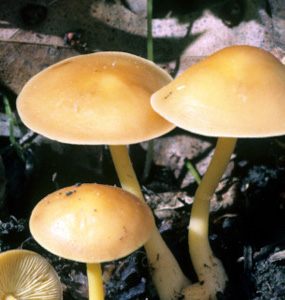Gymnopus dryophilus

Image Courtesy of Emily Johnson
| Click to Enlarge |
| Click For Image Gallery |
|
Group of Fungi: Agarics Family: Marasmiaceae Latin Name: Gymnopus dryophilus (Bull.) Murrill Synonym(s): Collybia dryophila (Bull.) P. Kumm. Common Name: Oak-loving Collybia Description: Total height 1–3 1/2 in (2.5–9 cm); cap 1–2 1/2 in (2.5–6.5 cm) wide, reddish brown to orange brown but becoming paler with age, upper surface smooth, margin sometimes upturned in age; gills closely spaced, white to pale pinkish buff; stalk 1–3 1/4 in (2.5–8 cm) long, 1/8–1/4 in (0.3–0.5 cm) in diameter, hollow, tough, white above and reddish-brown below; spores white to pale cream in mass. Biological Role: Decomposer of leaf litter and humus. Habitat: On the ground in broadleaf or mixed broadleaf/conifer forests; occurring in scattered groups or clusters. Geographical Distribution: Widely distributed throughout North America. Comments: As indicated by its common name, this fungus was once considered to be a member of the genus Collybia and is listed as Collybia dryophila in all but the newest field guides. It is particularly common in oak forests (hence "oak-loving"). Although often listed as edible, some people have developed severe gastrointestinal problems after consuming this fungus. |
| Go Back |